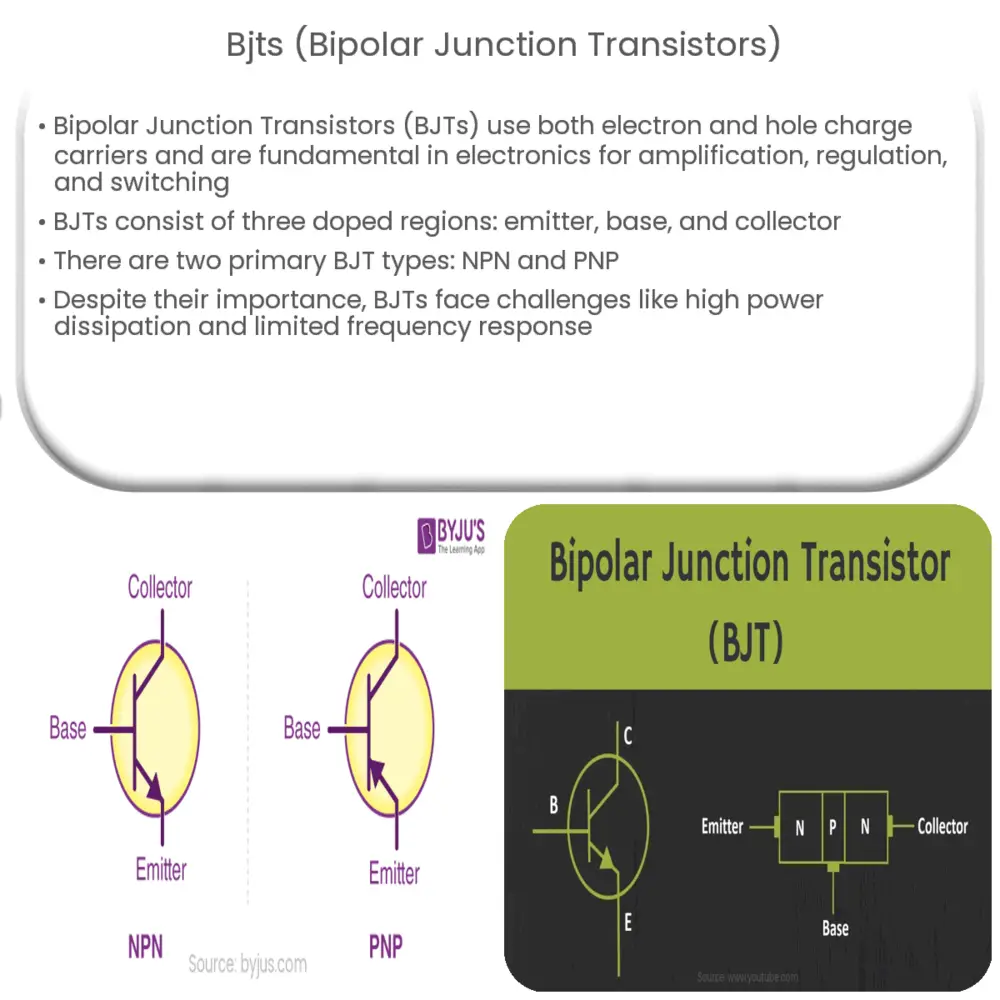Explore the fundamentals of Bipolar Junction Transistors (BJTs), their types, applications, biasing methods, and limitations.

Introduction to Bipolar Junction Transistors (BJTs)
Bipolar Junction Transistors, popularly known as BJTs, are a type of transistor that uses both electron and hole charge carriers. In the realm of electronics, BJTs serve as fundamental building blocks. They have a wide array of applications, such as amplification, regulation of electrical signals, and switching.
Construction and Working Principle
A BJT is a three-layer, two pn-junction device. It is composed of three doped semiconductor regions, namely the emitter, base, and collector. Each of these regions serves a distinct purpose and is characterized by its level of doping and size.
- Emitter: Heavily doped region that supplies the majority charge carriers (electrons in NPN, holes in PNP).
- Base: Lightly doped and thin region that controls the flow of charge carriers.
- Collector: Moderately doped region that collects the majority charge carriers from the emitter through the base.
The operation of a BJT relies heavily on the interaction of these three regions. Under normal operation, the emitter-base junction is forward-biased, meaning it allows current flow, while the base-collector junction is reverse-biased, inhibiting current flow. This configuration enables the BJT to amplify a weak input signal into a stronger output signal.
Types of Bipolar Junction Transistors
There are primarily two types of BJTs based on their construction and operation, namely NPN and PNP transistors.
- NPN Transistor: In an NPN transistor, the emitter and collector are N-type semiconductors, while the base is a P-type semiconductor. NPN transistors are most commonly used because they have better performance characteristics due to the higher mobility of electrons compared to holes.
- PNP Transistor: A PNP transistor has the emitter and collector made from P-type semiconductors, while the base is an N-type semiconductor. These transistors work essentially the same way as NPN transistors, but the voltage polarities and current directions are reversed.
These two types of transistors, despite their structural differences, serve similar functions in electronic circuits. Both are essential for a comprehensive understanding of electronics.
Applications of Bipolar Junction Transistors
The flexibility and fundamental operation of BJTs allow them to be used in a plethora of applications across various electronic devices and systems.
- Amplification: The most common use of BJTs is in amplifying signals. They are vital components in audio amplifiers, radio transmitters, and signal processing circuits.
- Switching: BJTs can function as switches. When in the saturation region, they operate as a closed switch, while in the cutoff region, they act as an open switch. This feature makes them ideal for digital logic circuits and relay drivers.
- Regulation: BJTs are instrumental in voltage and power regulation. They are key components in power supply circuits and linear voltage regulators.
The BJT Biasing
Biasing is a prerequisite for the transistor to work in the desired region of its characteristic curves. For BJTs, biasing is commonly used to establish a known quiescent operating point, or Q-point, to allow for signal amplification.
- Fixed Bias: In this configuration, the base current remains constant, and the output is taken across the collector resistor.
- Emitter Stabilized Bias: This technique employs a negative feedback mechanism, providing stability against temperature variations and β variations.
Limitations and Challenges
Despite the wide-ranging applications and functionalities of BJTs, they are not without limitations. BJTs can suffer from high power dissipation, which can lead to thermal runaway. The frequency response of BJTs is not as good as field-effect transistors (FETs). Furthermore, the physical size of BJTs is larger than FETs, which may be a disadvantage in high-density integrated circuits.
Conclusion
In conclusion, Bipolar Junction Transistors (BJTs) are vital components in the world of electronics. Their unique construction and operating principles facilitate their use in a broad range of applications, from amplification and switching to regulation of electrical signals. Though they have certain limitations, their relevance and utility in modern electronics cannot be understated. Understanding the working of BJTs is crucial for anyone looking to delve deeper into the intricate universe of electronic design and engineering.

